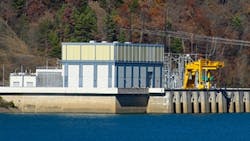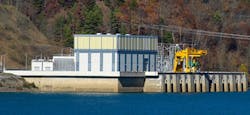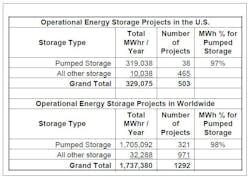Energy Storage: Let’s Not Neglect the Potential for New Pumped Hydro Storage
As has been referenced in recent reports, dozens of new large-scale pumped storage hydropower projects are being pursued (e.g. per the DOE’s Hydropower Market Report). So while the growth in battery-based electric energy storage is important and will provide ever-increasing benefits as it continues, it is important for us to put “traditional” pumped hydro storage in perspective.
Consider one of the largest hydro pumped storage facilities in the U.S.—the 3GW Bath County Pumped Storage Station (co-owned by Dominion and FirstEnergy):
If you needed several hours of power at a 3 GW capacity level, it would take around a million Tesla Powerwalls to do the same job as this one big plant. But to be fair, in contrast, if you wanted what we may call a “pumped hydro residential equivalent” of a single 13.5 kWh Tesla Powerall for your home, you’d need to install, along with your own generator/pump set-up, a 440-cubic-foot pool in your home’s attic—pumping its 14 tons of water up and down each time you needed to store and utilize desired energy.
While it is still a large-scale affair, pumped storage remains by far the dominant source of electric energy storage, at 97% of all U.S. MWh of utility-scale stored electric energy, and 98% of world-wise (see table).
Source: December 20, 2016 Transmission & Distribution World analysis of all DOE-reported Energy Storage Projects, DOE Global Energy Storage Database
As is well-known, a key limiting factor for greater utilization of pumped storage has always been geological—pumped hydro requires that a huge volume of water be stored in a reservoir at a high elevation, relative to the location of the reservoir’s generating facility.
All of the above considerations are why a recent announcement in Phys.org is so interesting. Titled “Hydroelectric engineers find potential in centuries-old mine,” the article highlights the efforts of Steve Burke and Jim Besha of Albany Engineering Corp. to secure a federal permit for using an abandoned, centuries-old iron mine as a new way to provide a steady flow of electricity in a growing market for renewable energy.
As stated in the article, Burke and Besha are pitching a plan to circulate some of the millions of gallons of groundwater that have flooded the mine shafts over the years to power an array of 100 hydroelectric turbines a half-mile underground.
They envision the operation as a solution for solar and wind power producers, who need ways to ensure an uninterrupted flow of energy when the sun isn't shining and winds are still.
"Today, everyone's recognizing that a critical part of our energy infrastructure is going to be storage. You can think of it as a bank. If someone has excess solar energy, they would pay a fee to store it overnight," Besha said.
While logistically complex, the plan is at the same time incredibly simple: Engineers would drain roughly half of the water from the shafts and pump the remainder into an upper chamber. The water would then be released into a lower chamber, powering turbines and creating electricity. The turbines would be reversed to pump the water back up to repeat the process.
About the Author
Peter Arvan Manos
Utility Industry Analyst
Peter Manos is Director of Research for Electric Power & Smart Grid, on the Energy Sector team at ARC. He analyzes the latest trends across People, Process, and Technology to uncover business and digital transformation best practices for electric, gas, and water utilities. He can be reached at [email protected]




